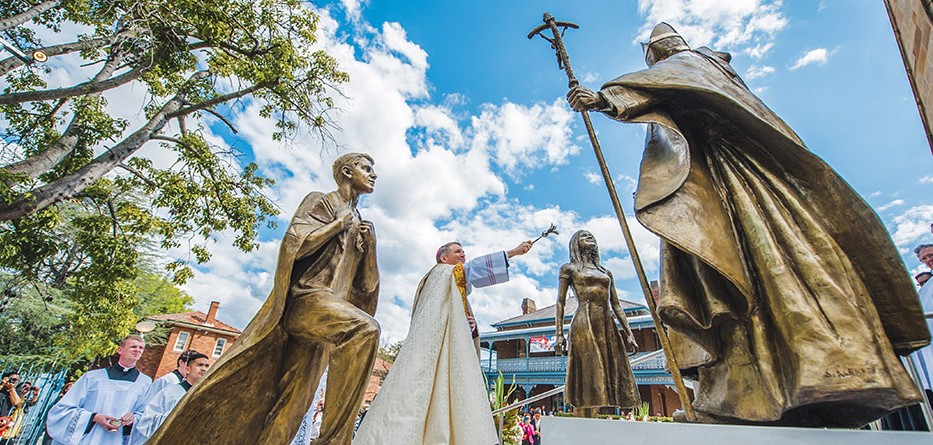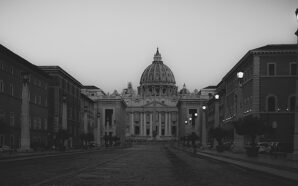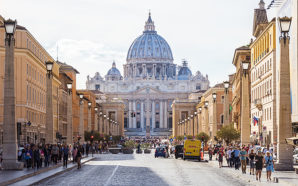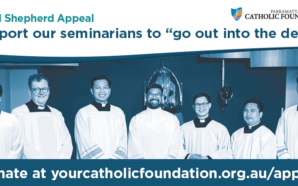To honour the Memorial of Pope St John Paul II, Catholic Outlook is republishing this September 2015 address by Archbishop Anthony Fisher OP, Archbishop of Sydney and Bishop of Parramatta from 2010 to 2014 at the unveiling of the St John Paul II Monument outside St Patrick’s Cathedral, Parramatta.
Remarks at the Unveiling of St John Paul II Monument
St Patrick’s Cathedral Precinct, Parramatta
5 September 2015
It’s great to be back in the Diocese of Parramatta for the unveiling and blessing of this John Paul II Monument, a project begun when I was bishop here. The reason this work was commissioned was that “John Paul the Great”, as he is popularly known, was in an important sense the father of this Diocese. He erected and visited it in 1986. He is also named here as Founder of World Youth Day, Pope of the Family and Apostle of the New Evangelisation: titles about which I will say more in a few moments.
1. John Paul the Great
On 8 April 2005, six days after his death, Karol Józef Wojtyła was buried. It was not your average funeral, state funeral, or even papal funeral: it was the largest gathering of heads of state in history, surpassing the funerals of kings, presidents and even Winston Churchill. Four kings, five queens, at least 70 presidents and prime ministers attended. The faithful came in unparalleled numbers, this Mass being the only serious competitor with the Mass celebrated by John Paul II for the 1995 World Youth Day in Manila for the title of largest single gathering of Christianity in history. In addition to more than four million mourners present in Rome, hundreds of millions joined through television and the net. And bishops and priests with their faithful at altars all around the world celebrated more or less contemporaneous Requiems.
In an historical rarity, leaders of other faiths also shared in the grief of Catholics. Chief amongst them at the funeral was the Ecumenical Patriarch Bartholomew; this was the first time such a patriarch had attended a papal funeral since the Great Schism. Archbishop Rowan Williams of Canterbury was also present, the first such time since the Church of England broke with Rome. The largest media contingent ever gathered for anything in history were there for the funeral and subsequent conclave.
Some compared the remarkable outpouring of grief with that of following the death of Princess Diana and the media were overwhelmingly sympathetic. Catholics like litanies – long lists of names of God, the Blessed Virgin and the saints by which we ask their help. After all, no one tag adequately captures or invokes them. Yet it was secular leaders and journos who immediately got to work on an unwitting litany to John Paul. They named him: “Actor-athlete turned scholar-pope”, “Destroyer of communism” and “Champion of freedom”, “Advocate of peace and reconciliation”, “Champion of the civilisation of love” and “Enemy of the culture of death”, “Friend of the poor”, “Voice of the voiceless”, “Force for Christian unity”, “Friend of Jews and Muslims”, “Father of World Youth Day”, “Apostle of the new evangelisation”, “Millennial pope” and “Faithful servant of God”. The most common name was the shortest: “John Paul the Great”.
He’s not the first to get that title. Various kings have had it: Charlemagne, for instance, means Charles the Great. The Bible includes the Selucid king Antiochius the Great and, of course, Herod the Great. We think of Alexander of Macedonia, Alfred of England and Catherine of Russia. Of humbler rank are the bishop-theologian St Basil the Great of Caesarea, the Dominican scientist-philosopher St Albert, the father of modern India Mahatma or ‘the Great’ Gandhi – and of course Gonzo the Great from the Muppets. Amongst the popes two received that title in the first millennium: Gregory I and Leo I. But the only one of the subsequent millennium to have that title by popular acclaim is, of course, John Paul II. There are many reasons a pope might get such a nickname. Let me give you a few reasons why he might rightly have that title.
2. Pope 1978-2005
The Gospels offer a number of moving vignettes of Jesus and Simon Bar-Jonah. At Lake Galilee he is called to leave his nets behind, “Come follow and be a fisher of men”. Later he returned to that sea to be challenged to walk on water as Christ tested and strengthened his faith. And a third time that faith was fortified at Galilee when Jesus commanded him to fish where fish there were none – or so it seemed. In due course Simon would express that faith on behalf of all the Church: “Lord, to whom else could we go? You have the words of everlasting life.” And again, “You are the Christ, the Son of the living God”. In exchange Jesus named him Petrus, Rocky, the Bedrockon which He would build His Church. He made him key-keeper, binder-looser, judge-absolver. He taught him, again and again, to be not afraid, to be washed and wash in turn, to tend the lambs and feed the sheep, to confirm the brethren, and go out to the world proclaiming the Good News. Peter didn’t always get it right, mind: he failed spectacularly on the night Jesus was betrayed; but happily he returned with even greater ardour, three times declaring his love and willingness to serve till death. So many New Testament stories are about Peter that it’s pretty obvious it’s not just about Peter. No, Jesus is setting up a line of Peters, a Petrine ministry, we know today as the papacy.This papa-cy, this Big Daddy will lead and serve the Church in good times and in bad, in sickness and in health.
John Paul was that kind of shepherd, fisher, binder-looser papa. Like Peter he could say, “Lord, you know I love you!” He too was willing to be led where he’d rather not go, far from his homeland and ultimately in chains, if not of steel, then of Parkinson’s disease. But first he went to the world. His longest of many pilgrimages was in 1986 when he travelled 50,000 km to Bangladesh, Singapore, Fiji, New Zealand, the Seychelles and Parramatta – with a few more Australian stops too. Wherever the sheep were, this shepherd ventured also, determined to find the lost, nurture the lambs, lead the sheep.
The Church has, of course, had many great popes. Some were great thinkers, doctors of the Church who proclaimed our faith and developed our understanding; others were more men of prayer or action. Some were great evangelizers, taking the Gospel to the ends of earth or sending others there; others focused on reform at home. Some rubbed shoulders with high and mighty; others reached out to the poor and marginalized. Some brought comfort and consolation; others were signs of contradiction and confrontation.
In John Paul II we had all of these kinds of pope: hence the title Great. His teachings filled more metres of book-shelves than all his predecessors put together, and ranged across many subjects. But he was no mere intellect: he had a profound piety and prayerfulness. His pastoral journeys brought him to Sydney three times, twice as pope, as he called us to join him in a new evangelisation. At home he sought to revolutionise the internal operations and external relationships of the Holy See. His preaching and behind-the-scenes diplomacy helped end the tyranny of communism in Eastern Europe and Russia and so, too, the Cold War. But his advocacy for the weak brought him into contest with the Western powers too, as he critiqued capitalist democracies that lack compassion for the unborn, poor and foreigners. He became a champion of human life and its cradles marriage, the family and a truly civil society. His stance for Catholic faith and morals made him a prophetic and divisive figure at times; but he could also be a great reconciler, as he worked to bring together Eastern and Western Christians, contending European powers, or the economically divided North and South. He apologised to those the Church had hurt and sort to defeat old enemies by making them friends. John Paul II led the Church and the world confidently but humbly from that 20th and bloodiest of centuries into a new century with hope and vision; with an assurance we are not doomed to repeat the world wars, genocides and massacres of innocents; with a challenge to respect the dignity and rights of everyone, share our affluence with the needy, and honour God above all.
3. Founder of the Diocese of Parramatta 1986
John Paul II was very much son and interpreter of the Second Vatican Council. On 28 October coming it will be fifty years since the Council issued Christus Dominus: On the Pastoral Office of Bishops. There the Council decreed that:
For a diocese to fulfil its purpose, the nature of the Church must be clearly evident to the people of God… The bishops must be able to carry out their pastoral duties effectively among their people… All this demands a re-examination of diocesan boundaries and redistribution of clergy and resources that is reasonable and responsive to the needs of the apostolate… Therefore, this sacred synod decrees that, to the extent required by the good of souls, a fitting revision of diocesan boundaries be undertaken prudently and expeditiously. This can be done by dividing or uniting them, by changing boundaries, determining a better place for the episcopal see or providing a new internal organization. [#22]
As Sydney’s Catholic population exploded through post-war immigration and the baby boom, there was long consultation and planning. It was finally proposed to the Holy Father that Sydney be divided in three, to become the Archdiocese, Parramatta and Broken Bay. In 1986 Pope John Paul acceded to that request and founded our new diocese; a few months later he visited us during that long pastoral journey down under. So you might say that the Diocese of Parramatta is a second class relic of St John Paul: it is from his hands, touched by his feet and once resonated with his voice as he told workers at the Transfield Factory about the dignity of work and the rights and responsibilities of labour.
The first time I met John Paul II was at a private audience when I was a young priest. After his talk we all stood in a circle around the walls of the room and he made his way around to meet all of us. (John Paul II met more people face to face than any other human being in history!) When he got to me I was introduced to him as a Dominican priest from Melbourne (that’s where I was working at the time). With a mischievous twinkle in his eye, and knowing exactly what he was doing, he said, “Melbourne? Mmmm. I remember Sydney.” No doubt he remembered his creation, the Diocese of Parramatta, as well!
4. Father of World Youth Day
Madison Square Garden in New York City is one of the most well-known sporting and entertainment venues in the world. But in 1979 the young John Paul II decided he’d like to meet American high school students there. Search YouTube and you’ll see a clip of him playing the crowd, making funny noises, faces and remarks in response to their whooping and clapping.[1] In Sydney he even joined young people in a sort of conga-line; in Melbourne for an impromptu Q&A. On other occasions he made glasses with his fingers to indicate the pope was watching the young people or swung his old man’s cane as if Charlie Chapman.
These episodes reflected his magnetic personality. When the young people chanted “John Paul II – we love you” he responded automatically, “John Paul II – loves you too!” His capacity to be close to young people and their concerns was long evident. Growing up in the shadows of the Nazis and Communists, he joined young people’s drama groups, entered a clandestine seminary, and later worked as priest, lecturer and youth chaplain. The students called him Wujek – Uncle – and they regularly joined him for trips that involved skiing, hiking, biking or camping with conversations about the meaning of life and decades of the rosary. Even as bishop, archbishop and then pope he made sure he still had opportunities to hear and talk to young people.
Not that JP2 romanticised young people or pandered to them: he expected a lot from them, set the bar high, challenging them with full cream Catholicism. He knew that youth is the time for settling personal identity and ideals, when conscience is tested, and sexuality and relationships develop or are deformed. He knew these had to be treasured if young people were to grow into their personal vocations, which are always expressions of the core vocation to love.[2]
Uncle JP’s love of youth was most spectacularly told by his decision, thirty years ago, to invite the youth of the world to join him in Rome on Palm Sunday 1985 for a celebration of their faith and ideals, to exchange views with him and their peers, and to pray and worship. It’s said his curial officials were appalled. Some feared it would be like Woodstock: loud, untidy, unspiritual and insanitary! Worse than a Catholic Woodstock, they feared it would be a failed Catholic Woodstock: that no-one would come. Young people, they said, just aren’t interested in religion anymore. They don’t want to pray with old priests in funny clothes. The me-generation are only interested in themselves, in getting ahead and getting things. The idealists who joined him for hiking and philosophy or who took part in civil rights marches in the 1960s were a thing of the past, they said. John Paul II knew better. He had great confidence in young people. He insisted that the event go ahead and took a big interest in its planning.
It came and was so popular it was repeated and thereafter held at various international venues every two or three years; in the other years more local celebrations are held on Palm Sunday. Some liturgists didn’t like him messing with the Holy Week calendar; some thought big Masses altogether too unruly. But it just got bigger and bigger. We now know these gatherings as ‘World Youth Days’ – though they are really a World Youth Week, with extras before and after if you come all the way from Aus. With their pope, bishops and chaplains young people experience a week of unabashed Catholicism, with catechesis, prayer, Stations, Vigil and Mass, and lots of fun. The journey of the cross and icon, welcome ceremony, ‘days in the diocese’, ‘youth festival’ events, national gatherings and other elements evolved. We had all that fun in 2008 when John Paul’s great friend and successor, Benedict XVI, came to our city. He also made it to Cologne, just as John Paul had held WYDs in Buenos Aires, Compostela, Czêstochowa, Denver, Manila, Paris, Rome and Toronto; and Pope Francis has taken the baton to Rio de Janeiro and next stop Kraków, hopefully with a big contingent of Parramattans.
5. Pope of the Family
In his homily for the canonisation of John Paul, Pope Francis dubbed him “Pope of the Family”. He no doubt had in mind John Paul’s famous catecheses on the theology of the body, his great apostolic exhortation Familiaris consortio, his founding an Institute for Marriage and the Family, a Pontifical Academy for Life and a Pontifical Council for the Family, and his many other teachings and projects in defence of life and love. He knew that young people don’t just hatch from eggs aged 18 or get beamed down from alien ships: to give them the best start in life we have to support family life better. So these two passions of JP2 – for youth and for family – were obviously closely related.
6. Apostle of the New Evangelisation
So, too, was all his work promoting the new evangelisation – preaching anew our ancient Gospel, with the modern means of communication, to people and situations that should already be Christian but fallen away. John Paul knew, for instance, that many young people who’ve been baptised, confirmed and Catholic schooled have little regular contact with parish, Mass, Confession, Scripture or other usual aspects of Catholic life. They might be good people, pray from time to time and carry a lot of Catholic baggage. But they are not as connected to Christ as He wants them to be, not as connected to Church as they and the Church need them to be.
Of course, that’s not only a young people’s problem. Five out of six Catholics in the Parramatta Diocese are not at Mass on a Sunday and that’s a big loss both for them and for us. Though Parramatta is doing better than most on that score it’s no cause for smugness. There’s lots to do in the new evangelisation and John Paul II’s pontificate was a provocation to us to get on with it. On this Pope Francis has been whistling very much the same tune.
The last time I saw Pope John Paul II alive I was an auxiliary bishop of Sydney on ad limina with Cardinal Pell. The Holy Father was very reduced by then, struggling to speak and more or less immobile. Yet at one stage during our meeting he stared at me directly, with what was by then his one good eye, and asked: “How many religious are there were in Australia?” How he had remembered that I belonged to a religious order I don’t know! But I answered that we still had a good number, but that religious life in Australia was in serious decline; there were some new movements and religious institutes emerging and some older ones were getting new members, but most were in decline, probably terminal decline. He looked away pensively. Then he turned back to me and said, “How many kangaroos are there in Australia?” I wondered if his mind was wandering… I said I understood there were about 60 million. Quick as a flash he said, “I want more religious than kangaroos!”
This was typical John Paul II, provoking me, provoking us, to not just bemoan a situation but get to, and do something about it. That’s the spirit of his new evangelisation.
7. Saint
Only the hierarchy of the Church can canonise a saint, but the faithful are often first to recognise authentic saintliness. At his funeral many cried out “Santo subito, now a saint, already a saint”. The canonical process and canonisation ceremony only confirmed what everybody knew.
Saints like John Paul may be holier than us but they are never ‘holier than thou’. Though they set the bar high, they never dismiss us as only capable of less. They want us in the front row, in this life and the next. Sure, they did brave deeds, taught wonderful truths, were pure-hearted and meek-spirited, gentle and merciful, suffered for justice and peace, were people of the beatitudes, the blessed-are guys (Mt 5:1-12). But in all this saints like JP2 are ordinary human beings – ordinary human beings who by God’s grace did extraordinary things. They were open to God working through them, with them and in them, and became transparent to that grace. People got closer to God by getting closer to them.
I was a young Dominican novice when I first saw John Paul II celebrate Mass in Canberra and meet with religious at the Sydney Opera House. I was fated to be a Catholic, religious and priest of the John Paul II generation, to end up meeting him several times in midlife, and be named a bishop by him. If I’d known all that was coming when first I saw him I might have run 1,000 km… But he made a deep impression on me, one that remains.
Though an unusually long papacy John Paul’s was still an unfinished symphony. At the dawn of a new century and millennium he handed over the baton to us: like Moses who didn’t enter the promised land himself, he charged us with going forward in his name, in Christ’s name, assuring us by his very motto, that we need not be afraid.
Reproduced with permission from the Catholic Archdiocese of Sydney.
[1] https://www.youtube.com/watch?v=3r-hnjwUBLk; http://www.nydailynews.com/news/national/new-yorkers-recall-live-changing-encounters-pope-john-paul-ii-article-1.1769744
[2] St John Paul II, Familiaris Consortio: Apostolic Exhortation on the Role of the Christian Family in the Modern World 11. See George Weigel, Witness to Hope: The Biography of Pope John Paul II 1920-2005 (London: HarperCollins, 2005), 493-4 citing John Paul II’s 1985 Apostolic Letter to the Youth of the World.








